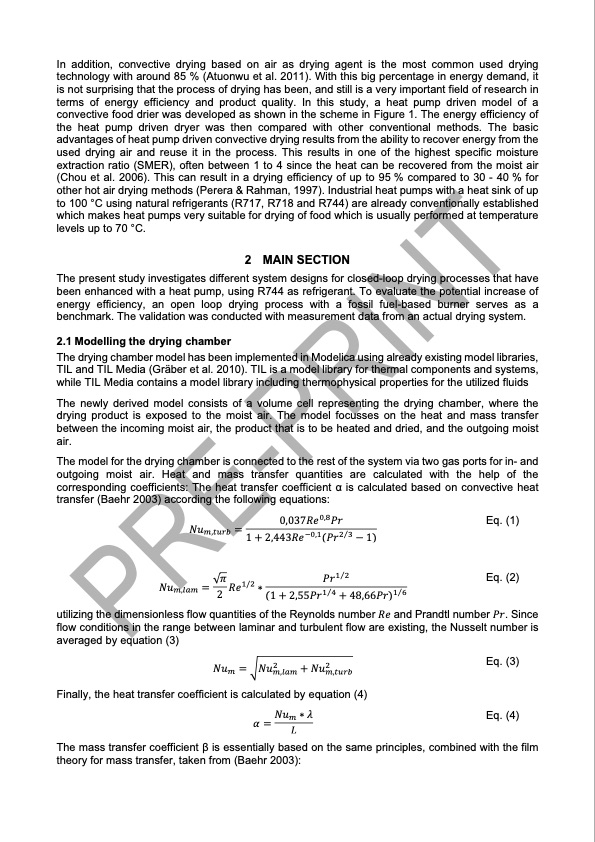
PDF Publication Title:
Text from PDF Page: 002
In addition, convective drying based on air as drying agent is the most common used drying technology with around 85 % (Atuonwu et al. 2011). With this big percentage in energy demand, it is not surprising that the process of drying has been, and still is a very important field of research in terms of energy efficiency and product quality. In this study, a heat pump driven model of a convective food drier was developed as shown in the scheme in Figure 1. The energy efficiency of the heat pump driven dryer was then compared with other conventional methods. The basic advantages of heat pump driven convective drying results from the ability to recover energy from the used drying air and reuse it in the process. This results in one of the highest specific moisture extraction ratio (SMER), often between 1 to 4 since the heat can be recovered from the moist air (Chou et al. 2006). This can result in a drying efficiency of up to 95 % compared to 30 - 40 % for other hot air drying methods (Perera & Rahman, 1997). Industrial heat pumps with a heat sink of up to 100 °C using natural refrigerants (R717, R718 and R744) are already conventionally established which makes heat pumps very suitable for drying of food which is usually performed at temperature levels up to 70 °C. 2 MAIN SECTION The present study investigates different system designs for closed-loop drying processes that have been enhanced with a heat pump, using R744 as refrigerant. To evaluate the potential increase of energy efficiency, an open loop drying process with a fossil fuel-based burner serves as a benchmark. The validation was conducted with measurement data from an actual drying system. 2.1 Modelling the drying chamber The drying chamber model has been implemented in Modelica using already existing model libraries, TIL and TIL Media (Gräber et al. 2010). TIL is a model library for thermal components and systems, while TIL Media contains a model library including thermophysical properties for the utilized fluids The newly derived model consists of a volume cell representing the drying chamber, where the drying product is exposed to the moist air. The model focusses on the heat and mass transfer between the incoming moist air, the product that is to be heated and dried, and the outgoing moist air. Eq. (1) Eq. (2) The model for the drying chamber is connected to the rest of the system via two gas ports for in- and outgoing moist air. Heat and mass transfer quantities are calculated with the help of the corresponding coefficients: The heat transfer coefficient α is calculated based on convective heat transfer (Baehr 2003) according the following equations: 0,037𝑅𝑅𝑅𝑅 𝑃𝑃𝑃𝑃 𝑁𝑁𝑁𝑁= 0,8 𝑚𝑚,𝑡𝑡𝑡𝑡𝑡𝑡𝑡𝑡 1 + 2,443𝑅𝑅𝑅𝑅−0,1(𝑃𝑃𝑃𝑃2⁄3 − 1) 𝑁𝑁𝑁𝑁 = √𝜋𝜋 𝑅𝑅𝑅𝑅1/2 ∗ 𝑃𝑃𝑃𝑃1⁄2 𝑚𝑚,𝑙𝑙𝑙𝑙𝑚𝑚 2 (1 + 2,55𝑃𝑃𝑃𝑃1⁄4 + 48,66𝑃𝑃𝑃𝑃)1⁄6 utilizing the dimensionless flow quantities of the Reynolds number 𝑅𝑅𝑅𝑅 and Prandtl number 𝑃𝑃𝑃𝑃. Since flow conditions in the range between laminar and turbulent flow are existing, the Nusselt number is averaged by equation (3) 𝑁𝑁𝑁𝑁 = �𝑁𝑁𝑁𝑁2 𝐿𝐿 + 𝑁𝑁𝑁𝑁2 𝑚𝑚 𝑚𝑚,𝑙𝑙𝑙𝑙𝑚𝑚 𝑚𝑚,𝑡𝑡𝑡𝑡𝑡𝑡𝑡𝑡 Eq. (3) Eq. (4) The mass transfer coefficient β is essentially based on the same principles, combined with the film theory for mass transfer, taken from (Baehr 2003): Finally, the heat transfer coefficient is calculated by equation (4) 𝛼𝛼= 𝑁𝑁𝑁𝑁𝑚𝑚 ∗ 𝜆𝜆PDF Image | Design of a CO2 heat pump drier with dynamic modelling tools

PDF Search Title:
Design of a CO2 heat pump drier with dynamic modelling toolsOriginal File Name Searched:
ICR2019_ID1333_HPD_Bantle_PrePrint.pdfDIY PDF Search: Google It | Yahoo | Bing
CO2 Organic Rankine Cycle Experimenter Platform The supercritical CO2 phase change system is both a heat pump and organic rankine cycle which can be used for those purposes and as a supercritical extractor for advanced subcritical and supercritical extraction technology. Uses include producing nanoparticles, precious metal CO2 extraction, lithium battery recycling, and other applications... More Info
Heat Pumps CO2 ORC Heat Pump System Platform More Info
| CONTACT TEL: 608-238-6001 Email: greg@infinityturbine.com | RSS | AMP |